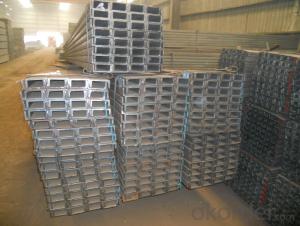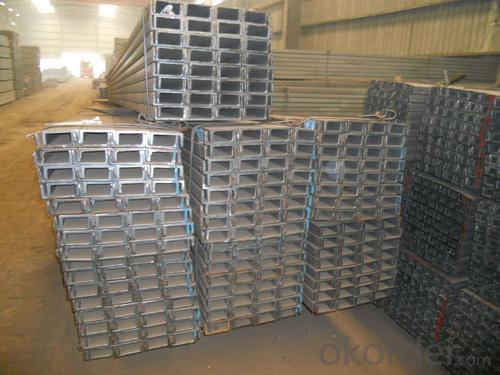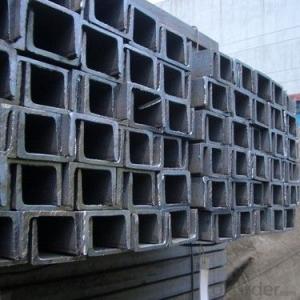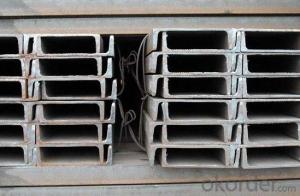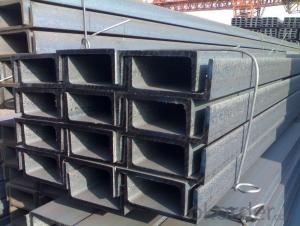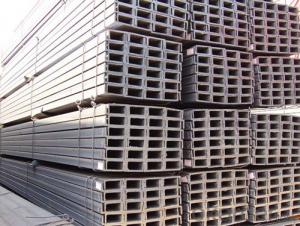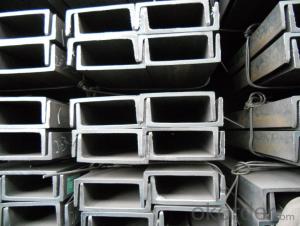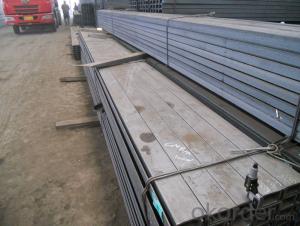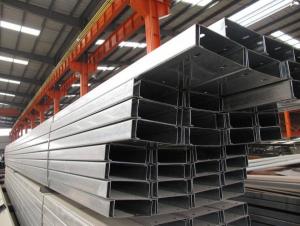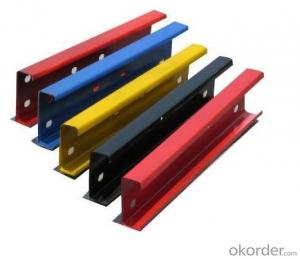High Quality Steel Channel
- Loading Port:
- China Main Port
- Payment Terms:
- TT OR LC
- Min Order Qty:
- -
- Supply Capability:
- -
OKorder Service Pledge
OKorder Financial Service
You Might Also Like
Specifications of JIS Channel Steel:
1. We are definitely speciallizing in manufacturing and supplying channel steel as per japanese standard, which is characterised with high mechanical strength and competitive prices.
| Standard | JIS G3192 |
| Material Grade | SS400 |
| Sizes | 50mm to 200mm |
| Sales Volume/Year | 3000MT |
| Destination Area | Middle East, Africa, Southeast Asia |
Size and Mass:
| Size (mm) | Mass (Kg/m) | Size (mm) | Mass (Kg/m) |
| 50*25*3.0 | 2.37 | 75*40*4.5 | 5.85 |
| 75*40*3.8 | 5.30 | 75*40*5.0 | 6.92 |
| 75*40*4.0 | 5.60 | | |
The mechanical property of JIS Channel Steel:
Grade | Yield Strength,N/mm² | Extension Strength N/mm² | |||
Thickness of Steel,mm | |||||
≦16 | >16-≦40 | >40-≦100 | >100 | ||
SS400 | ≧245 | ≧235 | ≧215 | ≧205 | 400-510 |
Package & Delivery of JIS Channel Steel:
1.The channel steel will be packed in bundle with steel wire at each end of every bundle and color marking in order to help the customer to recognize his goods more easily at sight.
2. And the channel steel could be loaded into 20ft or 40ft container, or by bulk cargo.If the weight of each bundle reaches more than 3.5 mt, the loading by break bulk cargo should be choosed.When the weight of each bundle reaches less than 3mt, the loading by container should be choosed.
3.As for the transportaion from mill to loading port, the truck will be usually used. And the maximum quantity for each truck is 40mt.
4.All in all, we could do in accordance with customer's request.
*If you would like to get our price, please inform us the size, standard/material and quantity. Thank you very much for your attention.
- Q: Can steel channels be used for curtain wall systems?
- Curtain wall systems can utilize steel channels, which serve as the framing system and provide structural support for the attachment of glass panels or cladding materials. These systems are typically made of lightweight materials like aluminum or steel, creating a non-structural exterior wall system that protects against weather conditions. Steel channels offer numerous advantages, including their high strength-to-weight ratio, durability, and ability to be prefabricated off-site for efficient installation. Nonetheless, it is crucial to consider the specific design requirements and load calculations to ensure the steel channels meet the necessary structural and performance criteria for curtain wall systems.
- Q: What are the different methods of painting steel channels?
- There are several methods of painting steel channels, each with its own advantages and considerations. 1. Brush painting: This is the most basic and traditional method of painting steel channels. It involves using a paintbrush to apply paint directly onto the surface of the channel. Brush painting is suitable for smaller projects or areas that require precise and detailed work. However, it can be time-consuming and may result in brush marks or uneven coverage. 2. Spray painting: Spray painting is a popular method for painting steel channels, especially for larger projects or areas that require a smooth and even finish. It involves using a spray gun or aerosol can to apply a fine mist of paint onto the surface. Spray painting allows for quick and efficient coverage, and it can reach difficult-to-access areas. However, it requires proper ventilation and protective equipment to ensure safety. 3. Powder coating: Powder coating is a highly durable and long-lasting method of painting steel channels. It involves applying a dry powder paint onto the surface, which is then cured with heat to form a smooth and protective finish. Powder coating offers excellent resistance against corrosion, chemicals, and UV rays. It is commonly used in industrial applications and provides a wide range of color options. However, powder coating requires specialized equipment and expertise, making it more suitable for professional applications. 4. Electrostatic painting: Electrostatic painting is a technique that uses electrostatic charge to attract paint particles onto the steel channel's surface. It involves using a spray gun that produces a charged paint mist, which is then attracted to the grounded channel. This method ensures even coverage and minimizes overspray. Electrostatic painting is commonly used in situations where a high-quality finish and uniform coating thickness are required. 5. Dip painting: Dip painting involves immersing the steel channel into a tank or container filled with paint. This method is suitable for objects with complex shapes or hard-to-reach areas. The channel is dipped into the paint, allowing it to coat the surface evenly. Dip painting can achieve a uniform finish, but it requires careful control of the immersion process to prevent excess paint buildup or drips. Each method has its own advantages and considerations, and the choice of painting method depends on factors such as the project size, desired finish, durability requirements, and available resources. It is important to consider the specific needs and constraints of the project before selecting the most suitable method for painting steel channels.
- Q: How do steel channels contribute to sustainability?
- Steel channels contribute to sustainability in several ways. Firstly, steel is a highly durable and long-lasting material. This means that steel channels can withstand harsh environmental conditions and have a longer lifespan compared to other materials. As a result, fewer replacements and repairs are needed, reducing waste and conserving resources. Secondly, steel is a highly recyclable material. At the end of their life cycle, steel channels can be easily recycled and reused to produce new steel products. Recycling steel requires less energy and produces fewer greenhouse gas emissions compared to the production of virgin steel. This helps to conserve natural resources and reduce the carbon footprint of the construction industry. Furthermore, steel channels are lightweight and versatile, making them easier to transport and install. This reduces the need for heavy machinery and minimizes the environmental impact associated with transportation and construction activities. Additionally, steel channels can contribute to energy efficiency in buildings. They can be used as structural elements in sustainable construction practices such as green roofs and solar panel installations. These practices help to reduce energy consumption by improving insulation and harnessing renewable energy sources. Overall, steel channels play a significant role in promoting sustainability by being durable, recyclable, lightweight, and energy-efficient. Their use in construction and infrastructure projects helps to minimize waste, conserve resources, reduce greenhouse gas emissions, and create more sustainable built environments.
- Q: Can steel channels be used in the automotive industry?
- Yes, steel channels can be used in the automotive industry. Steel channels are versatile and commonly used in various applications within the automotive sector. They are frequently employed in the construction of car frames, chassis, and other structural components. The high strength and durability of steel channels make them ideal for providing support and stability to vehicles. Additionally, steel channels are also utilized in the manufacturing of body panels, seat frames, and other interior components. The use of steel channels in the automotive industry ensures the production of safe and long-lasting vehicles.
- Q: Are steel channels suitable for use in warehouse storage systems?
- Indeed, warehouse storage systems can make effective use of steel channels. Steel channels offer a robust and enduring structure that can bear the weight of heavy loads within a warehouse. They possess the capability to withstand the pressure generated by diverse storage items, and can be employed in various storage arrangements, including pallet racking systems, shelving units, or mezzanine platforms. Steel channels exhibit resistance to harm, corrosion, and wear, thereby guaranteeing an extended lifespan for the storage system. Moreover, they can be conveniently personalized and altered to suit different storage requirements and configurations, rendering them a flexible option for warehouse storage systems.
- Q: What are the factors to consider when determining the appropriate width of a steel channel?
- When determining the appropriate width of a steel channel, several factors need to be considered. Firstly, the load-bearing capacity of the channel is crucial. The width of the channel should be sufficient to support the expected load without bending or buckling. The weight and distribution of the load, as well as any dynamic forces or vibrations, should be taken into account while calculating the required width. Secondly, the span length or distance between the supports is an important factor. Longer spans require wider channels to provide adequate support and prevent sagging or deflection. Thirdly, the material properties of the steel channel need to be considered. The strength and stiffness of the material influence the required width. Using steel with higher tensile strength or a higher modulus of elasticity may allow for narrower channel widths while maintaining the necessary structural integrity. Additionally, the intended use or application of the steel channel should be considered. Different applications may have specific requirements for the width of the channel. For example, in building construction, the width of steel channels used for beams or columns would be determined by structural design codes and standards. Furthermore, the fabrication and installation processes should be taken into account. The width of the steel channel should be practical for manufacturing, transportation, and installation purposes. It should be feasible to produce the desired width within the capabilities of the steel manufacturer, and it should be manageable to transport and erect the channel at the construction site. Lastly, cost considerations play a role in determining the appropriate width of a steel channel. Wider channels generally require more material, resulting in higher costs. However, using a narrower channel than required may compromise the structural integrity and safety, which may lead to additional costs in the long run. In conclusion, the factors to consider when determining the appropriate width of a steel channel include the load-bearing capacity, span length, material properties, intended use, fabrication and installation processes, and cost considerations. By carefully evaluating these factors, an appropriate width can be determined to ensure the structural integrity and functionality of the steel channel.
- Q: How to input the sign of channel steel in Excel
- The channel is the section for the steel strip shape groove, the specifications with the waist high (H) (b) * * legs wide waist thick (d) mm number representation, such as 100*48*5.3, said 100 mm high waist, leg width is 48 mm, 5.3 mm thick waist channel, or 10# channel.
- Q: Can steel channels be used in modular data centers?
- Yes, steel channels can be used in modular data centers. Steel channels provide structural support and stability, making them suitable for use in modular data centers where robust and durable construction is required.
- Q: Can steel channels be used for overhead door framing?
- Yes, steel channels can be used for overhead door framing. Steel channels are commonly used in construction for structural support and framing. They are strong and durable, making them suitable for supporting the weight of an overhead door. Steel channels can be easily fabricated and installed to create a sturdy frame for the door. Additionally, steel channels provide stability and ensure proper alignment of the door, making them a popular choice for overhead door framing.
- Q: What is the minimum size of channel steel?
- Channel 5# channel, width of 50 mm, 37 mm high leg, thickness 4.5 mm.
Send your message to us
High Quality Steel Channel
- Loading Port:
- China Main Port
- Payment Terms:
- TT OR LC
- Min Order Qty:
- -
- Supply Capability:
- -
OKorder Service Pledge
OKorder Financial Service
Similar products
Hot products
Hot Searches
Related keywords
